Effective Cleaning Methods for Glass Stove Cooktops
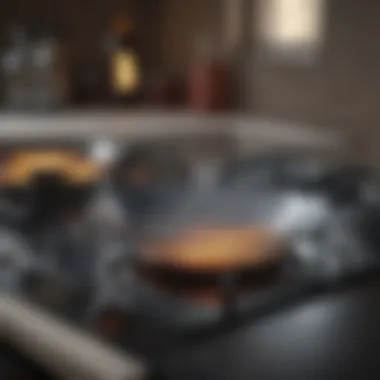
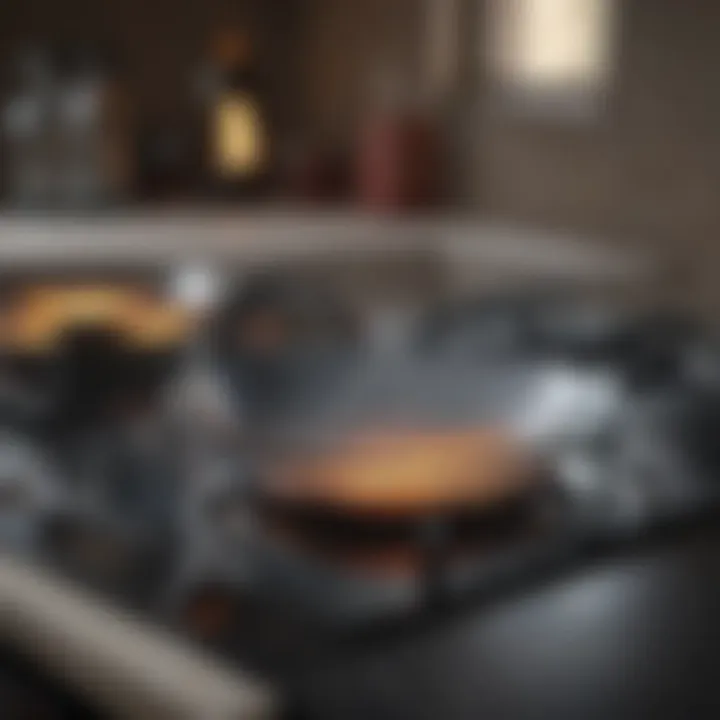
Intro
Glass stove cooktops are often admired for their sleek appearance and modern design. However, they demand specific care to maintain their functionality and clarity. Understanding the proper techniques for cleaning these surfaces can enhance both their performance and aesthetics. In this guide, we will delve into practical methods for ensuring that your glass stove cooktop remains spotless and operational for years to come.
A clean cooktop not only improves the overall look of your kitchen but also promotes efficiency during cooking. With the right products and techniques, you can easily remove stubborn baked-on residues and maintain a pristine surface. This article comprehensively covers essential preparation steps, effective cleaning techniques, suitable products, and preventative measures that will prolong the life of your glass stove cooktop.
By following the insights provided here, you will gain the knowledge necessary to tackle the challenges associated with cleaning glass cooktops without damaging their delicate surface.
Prelims
Cleaning glass stove cooktops is not simply a matter of maintaining aesthetics; it has broader implications for functionality and hygiene. Glass cooktops are popular in modern kitchens due to their sleek design and ease of use. However, they require specific care to preserve their appearance and performance over time. High-temperature cooking can lead to stubborn stains and burnt-on food residues, which can be challenging to remove if not addressed promptly. This article will delve into effective techniques and products for cleaning glass stove cooktops, ensuring they remain not only visually appealing but also functionally viable.
One essential aspect is that regular cleaning can prevent long-term damage. Neglected surfaces may become scratched or discolored over time, diminishing the cooktop\u2019s appeal. Moreover, food particles left on the surface can burn during subsequent cooking sessions, creating additional work for the next cleaning round. Keeping the cooktop in good condition contributes to a healthier cooking environment, minimizes fire hazards, and enhances overall kitchen efficiency.
This guide outlines vital preparatory steps, practical cleaning techniques, and preventative measures aimed at preserving the quality of glass stove cooktops. The insights shared here target discerning individuals who wish to maintain a high standard in kitchen care, contributing to their broader goals of home management and design. By incorporating these strategies, users can ensure their cooktops are always ready for use, thus enhancing both their daily cooking experience and the overall ambiance of their kitchen.
Understanding Glass Stove Cooktops
Cleaning glass stove cooktops can be tricky without a solid understanding of the cooktop itself. Different glass stove types offer unique features, and understanding these can lead to better maintenance and preservation. Additionally, recognizing common design elements helps users utilize the cooktops effectively and safely. This knowledge is not only valuable for improving aesthetics in the kitchen but also assures functionality in daily cooking tasks.
Types of Glass Cooktops
There are primarily two types of glass cooktops: radiant and induction.
- Radiant Cooktops: These use electric coils beneath the glass surface that heat up when switched on. This type is versatile and compatible with many cookware materials, but it can heat slowly and retain heat longer.
- Induction Cooktops: Unlike radiant cooktops, induction directly heats the cookware using magnetic fields. This means they heat up faster and provide precise temperature control. However, they work only with magnetic cookware.
Understanding these distinctions is beneficial when selecting the right cleaning method. Radiant cooktops may require more cleaning attention due to higher temperatures leading to burnt spots, whereas induction surfaces often remain cleaner, as they heat pots rather than the cooktop itself.
Common Features
Various features can enhance the functionality of glass stove cooktops. Some common attributes include:
- Smooth Glass Surface: A seamless cooking area allows for easier cleaning and maintenance. It also provides an elegant appearance.
- Touch Controls: Many modern glass cooktops include touch-sensitive controls. These can simplify operation but may require careful cleaning to avoid damage.
- Indicator Lights: Most units have safety indicators that alert users when the surface remains hot, which is crucial for preventing burns.
- Self-Diagnostics: Some models offer self-diagnostic capabilities to troubleshoot issues automatically, ensuring better longevity.
Each of these features plays a role in both user experience and maintenance. Knowing how to clean different aspects properly can help keep the cooktop not just functional but also looking new for longer.
"Understanding the attributes of your glass stove cooktop can drastically improve your maintenance habits."
Equipping oneself with the right knowledge about types and features sets a foundation for effective cleaning methods, fostering a more enjoyable cooking experience.
Preparing for Cleaning
Cleaning a glass stove cooktop may seem like a simple task, but proper preparation is essential for achieving the best results. Taking the time to gather the right materials and understanding the importance of safety precautions can greatly improve your cleaning experience. This section emphasizes why preparing for cleaning is not just a step, but a crucial part of maintaining the functionality and appearance of your cooktop.
First, preparing for cleaning helps prevent potential damage. Glass stove cooktops are sensitive surfaces that can scratch or crack if not treated with care. By knowing what materials to use and how to handle them, you minimize the risk of harming the cooktop. Using the wrong tools or cleaners can lead to expensive repairs or replacement.
Another benefit of preparation involves efficiency. Collecting all necessary supplies ahead of time streamlines the cleaning process. It saves you from interruptions and allows you to focus on the task at hand. An organized approach lays the foundation for a thorough cleaning.
Moreover, understanding the safety precautions prepares you for a secure cleaning session. Some cleaning products may release harmful fumes or irritate the skin. By considering safety first, you create a better cleaning environment for yourself.


In summary, preparing for cleaning is essential for effective maintenance of glass stove cooktops. By gathering supplies and observing safety measures, you ensure a smooth, hassle-free experience that protects your appliance.
Gathering Cleaning Supplies
To efficiently clean your glass stove cooktop, it's vital to gather the right cleaning supplies. Here’s a list of essential items that will help you achieve a thorough clean:
- Microfiber cloths: These are gentle on surfaces and effective at picking up grime.
- Cooktop cleaner: Look for products specifically designed for glass stoves, such as Weiman or Cerama Bryte.
- Scraper tool: A plastic scraper is effective for removing stubborn burnt-on food without scratching the glass.
- Warm water: Used for dampening cloths or rinsing off cleaners.
- Baking soda: A natural and gentle abrasive that can help with tougher stains.
By having these supplies on hand, you're setting yourself up for success in cleaning your cooktop.
Safety Precautions
When cleaning a glass stove cooktop, safety should always be a priority. Here are important safety precautions to consider:
- Ensure the cooktop is cool: Always wait for the surface to cool down before starting the cleaning process. Cleaning a hot surface can result in burns or damage to the cooktop.
- Wear gloves: If you are using strong cleaners or scrapers, wear gloves to protect your skin from irritants.
- Provide ventilation: Open windows or turn on fans when using commercial cleaners. Good airflow helps reduce the concentration of fumes that can be harmful.
- Read labels: Always check the instructions on cleaning products. Some may have specific instructions or warnings that are crucial for safety.
Taking these precautions not only ensures your safety but also extends the lifespan of your glass stove cooktop. Prior planning and safety measures lead to a more effective and responsible cleaning process.
Basic Cleaning Techniques
Basic cleaning techniques are fundamental to maintaining the aesthetic appeal and functionality of glass stove cooktops. Regular cleaning is essential as it prevents the buildup of stains and grease, which can be difficult to remove if left unattended. Proper cleaning not only enhances the appearance of the cooktop but also prolongs its lifespan and ensures optimal cooking performance.
Daily Maintenance
Daily maintenance is vital for keeping your glass stovetop in pristine condition. It involves a simple routine that significantly reduces the effort required for deep cleaning later. Here are the key aspects of daily maintenance:
- Wipe Down After Use: As soon as you finish cooking, take a damp cloth or sponge to wipe off any spills. Warm, soapy water works well for this purpose.
- Avoid Harsh Chemicals: Using harsh chemicals can damage the surface. Stick to mild dish soap or glass cleaner that is specifically designed for cooktops.
- Use Soft Cloths: Always choose non-abrasive cloths or sponges to avoid scratching the glass surface. Most microfiber cloths are excellent for this task.
- Check for Stubborn Residues: If you notice any dried-on food particles, it is best to remove them immediately. You can dampen the cloth and let it sit on the residue for a few minutes before wiping.
By incorporating these daily practices, you minimize the long-term damage to your cooktop, making subsequent cleaning easier.
Deep Cleaning Procedures
Despite regular maintenance, there are times when a more thorough clean is necessary. Deep cleaning helps tackle those stubborn stains and burnt residues that accumulate over time. Here are the procedures to follow:
- Gathering Supplies: Start by collecting the right supplies. You will need a glass stove cleaner, a plastic scraper, and soft cloths. These will help in removing tough residues without scratching the surface.
- Cool Down the Cooktop: Always ensure that the stove is completely cool before you start. Cleaning a hot surface can be dangerous and may cause burns.
- Applying the Cleaner: Spray the glass stove cleaner generously over the affected areas. Allow it to sit for a few minutes to soften the grime.
- Scraping Residue: Use a plastic scraper to gently lift off the softened stains. Always scrape at a slight angle to avoid scratches.
- Final Wipe: After scraping, wipe down the entire cooktop with a damp cloth to remove any leftover cleaner and residue. Follow up with a dry microfiber cloth for a streak-free shine.
"Regular deep cleaning ensures the longevity of your glass stove cooktop, enhancing both its appearance and performance."
Deep cleaning should be performed at least once a month or more frequently if you use your stovetop often. This proactive approach keeps your appliance in top shape and can prevent more extensive damage down the line.
Engaging in consistent daily maintenance and recognizing the need for deep cleaning are crucial practices in caring for glass stove cooktops. This careful attention to cleaning truly pays off in the long run.
Specific Cleaning Products
Cleaning your glass stove cooktop effectively requires appropriate cleaning products. These products can be a game-changer in terms of both efficiency and safety. Having the right supplies helps maintain the aesthetic appeal and functionality of the cooktop. Here, the focus will be on two primary categories of cleaning products: commercial cleaners and natural alternatives. Each has its unique advantages and considerations worth discussing.
Commercial Cleaners
Commercial cleaners are widely available and specifically formulated for glass stove tops. They often contain powerful ingredients designed to tackle tough stains and burnt-on food residues. One significant advantage of commercial cleaners is their convenience. Users can find these products ready to use, eliminating the need for mixing or diluting. This is particularly beneficial for individuals with busy lifestyles.
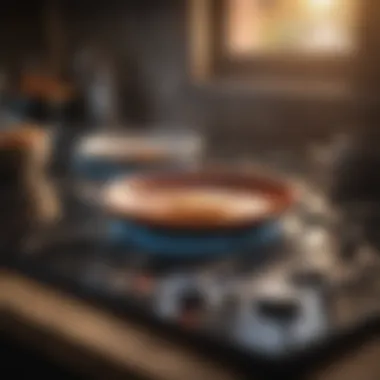
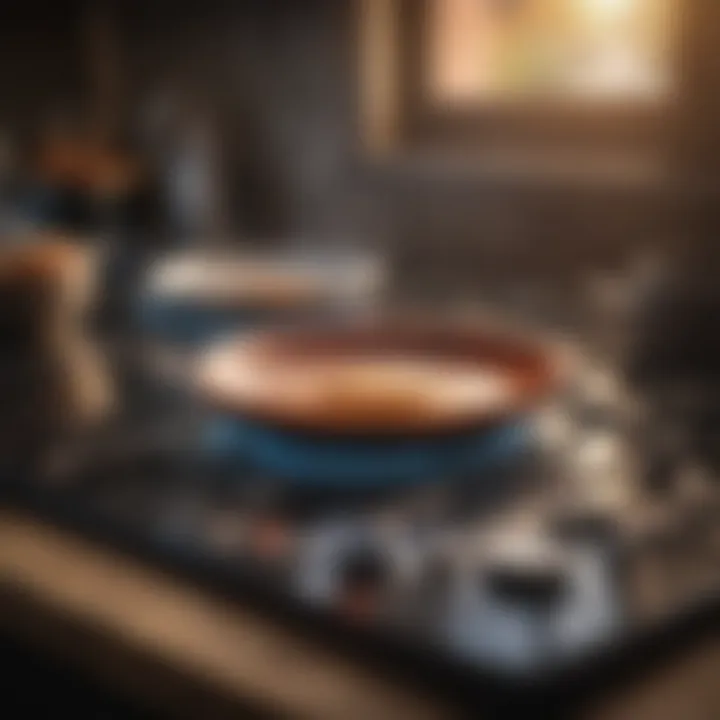
However, it is crucial to read the labels before purchasing any commercial product. Look for cleaners that mention "scratch-free" or "safe for glass" to ensure they will not damage the stovetop. Brands such as Cerama Bryte and Weiman have specialized products aimed at providing effective cleaning without harsh abrasives. Following the manufacturer’s instructions is vital to achieve the best outcome.
"Using a cleaner not meant for glass surfaces can lead to permanent damage."
Regular use of commercial cleaners can also be helpful in maintaining a streak-free shine on the surface. Often, they provide a pleasant scent, adding an olfactory dimension to the cleaning experience. However, some products may contain chemicals that can be harsh or irritate sensitive skin. Users should wear gloves to protect their hands and ensure proper ventilation while cleaning.
Natural Alternatives
For a more eco-friendly approach, natural cleaning alternatives offer compelling options for maintaining glass stove cooktops. Ingredients like vinegar, baking soda, and lemon juice can serve as effective cleaning agents. They help lift stains and neutralize odors without the use of strong chemicals.
Using a mixture of baking soda and water can create a gentle abrasive paste ideal for scrubbing away stubborn grime. This method is particularly advantageous for those who prefer to minimize their exposure to synthetic products.
Another effective natural solution is a mixture of vinegar and water in a spray bottle. This can be sprayed onto the surface and wiped with a microfiber cloth, leaving it spotless. Additionally, vinegar has antibacterial properties, providing some measure of sanitation.
While natural cleaners can be effective, they may require more effort than commercial products. For instance, stubborn stains could need soaking time or repeated applications. Despite this, natural alternatives come with the added benefit of being safe for the environment and family, particularly for households with small children or pets.
Cleaning Stains and Burn Marks
Keeping a glass stove cooktop clean is crucial not only for aesthetic purposes but also for its functionality. Stains and burn marks can detract from the visual appeal of the cooktop and may even interfere with cooking efficiency. Understanding how to effectively address these imperfections is essential for maintaining the longevity and quality of your appliance.
Addressing Tough Stains
Tough stains can be a significant concern for glass stove owners. They can result from spilled food, grease buildup, or other substances that adhere to the glass surface. The longer a stain remains untreated, the harder it becomes to remove. Here are a few strategies:
- Identifying the stain type: Knowing the nature of the stain helps in selecting the right cleaning method. Common stains include cooked-on food, grease, and water spots.
- Using the right tools: A non-abrasive sponge or cloth is essential. Avoid using metal scrubbers, as they can scratch the surface.
- Employing suitable cleaners: For persistent stains, using a commercial glass cooktop cleaner can be effective. These products are specifically formulated to dissolve tough residues without harming the glass. Natural options might include baking soda mixed with water or white vinegar, which can serve as mild abrasives.
To effectively remove a tough stain, apply the cleaner, let it sit for a few minutes, and then gently scrub the area in a circular motion. Rinse thoroughly and dry the surface to avoid streaks.
Handling Scratches
Scratches can be another source of frustration. While prevention is ideal, sometimes scratches occur despite careful usage. Although a deep scratch may require professional attention, there are methods to minimize their appearance:
- Assessing the scratch: Determine if it is superficial or deep. Superficial scratches can often be treated at home.
- Use of polishing compounds: Light scratches can sometimes be smoothed out using a glass polishing compound. Apply a small amount to a soft cloth, and gently buff the scratched area until it appears less noticeable.
- Preventative measures: To avoid future scratches, consider using cookware that is designed for glass surfaces. Ensure that pots and pans have smooth bottoms to minimize contact damage.
Staying proactive about cleaning and maintenance can significantly enhance the lifespan of your glass cooktop and keep it looking new.
By addressing stains and scratches right away, you can maintain both the appearance and functionality of your glass stove cooktop. Regular inspections and immediate actions help prevent long-term damage.
Preventative Practices
Taking care of a glass stove cooktop involves not only cleaning but also implementing preventative practices. These measures are essential to preserving the surface and functionality of the cooktop. Proper care can help to avoid scratches, discoloration, and other damages that can lead to costly repairs or replacements. Understanding these practices can enhance the longevity and appearance of your cooktop.
Avoiding Damage
To maintain the glass surface, avoiding damage is crucial. This involves using appropriate cookware; heavy or rough materials such as cast iron can scratch the surface. It's advisable to choose flat-bottomed pans. Ensure they have no sharp edges that might scratch the glass when moved.
Additionally, foods with high sugar content can caramelize and burn onto the cooktop. Such spills should be cleaned promptly before they become difficult to remove. Always use a cutting board when preparing food. Cutting directly on the cooktop’s surface invites scratches and can damage it over time.
Here are some key practices to avoid damage:

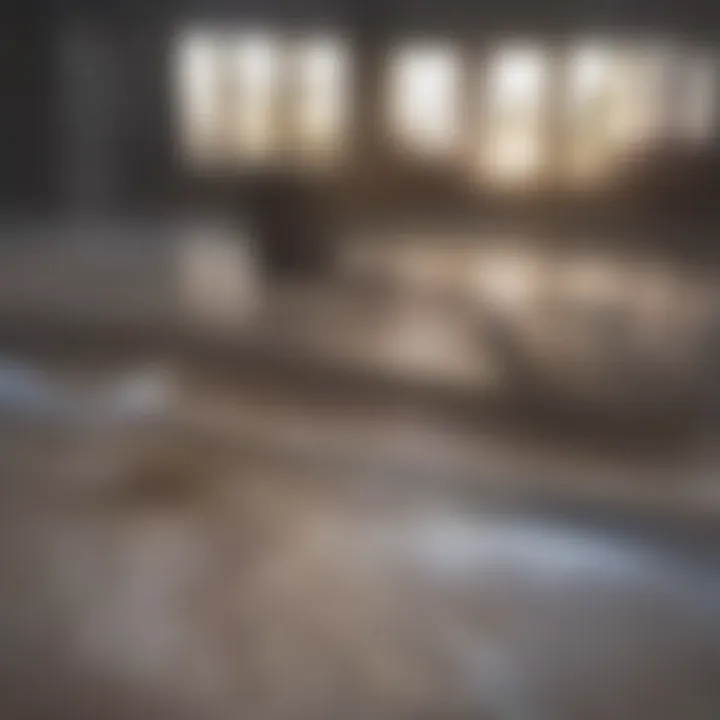
- Use the right size pots and pans to prevent overflow.
- Always lift cookware instead of sliding it across the surface.
- Clean up spills immediately, especially sugary and acidic substances.
By following these guidelines, you can significantly reduce the risks associated with daily cooking.
Maintaining Even Surface Temperature
Maintaining an even surface temperature is another important aspect of care. Sudden temperature changes can cause thermal shock, which might result in cracks or other damage. Thus, it is wise to gradually heat the cooktop instead of turning on high heat immediately.
Use only pans that suit the cooktop's material, as certain metals can transfer heat unevenly, leading to hot spots on the glass surface.
Consider the following tips:
- Preheat the cooktop before adding food, especially for frying.
- Avoid using high heat settings unless necessary.
- Monitor food closely to adjust temperatures as needed.
By adopting these practices, you can maintain the integrity of the glass stove cooktop and ensure even cooking results.
Professional Cleaning Services
In certain situations, individuals might find themselves in need of professional cleaning services for their glass stove cooktops. This need arises when standard cleaning methods prove insufficient or the buildup becomes too extensive. Engaging professionals can also safeguard against potential damage caused by improper cleaning techniques.
A clean glass cooktop not only enhances the kitchen aesthetic but can significantly contribute to better functionality. Regular maintenance restricts heat retention and enhances efficiency, thereby elongating the lifespan of the appliance. However, professional services often offer more than just thorough cleaning; they bring expertise and specialized tools to the table, ensuring a deep clean that homeowners may not achieve on their own.
Furthermore, professionals are trained to identify and resolve underlying issues that might not be immediately visible. This proactive approach not only assists in maintaining the cooktop but can ultimately save money in the long run by preventing costly repairs. The following sections will delve into when one should consider these services and how to evaluate available options.
When to Consider Professional Help
Identifying the right moment to consider hiring professional cleaning services can impact both the effectiveness of the clean and the longevity of the glass cooktop. Here are several scenarios where professional intervention is advisable:
- Persistent Stains: If stains or marks remain despite repeated cleaning attempts, professionals can utilize advanced techniques and products to remove them effectively.
- Heavy Buildup: For those who may not have maintained the cooktop regularly, significant grease and grime buildup warrant a professional deep clean.
- Damage Assessment: If there are scratches, chips, or any other damage evident on the cooktop, it is prudent to consult professionals before attempting any DIY solutions.
- Time Constraints: For busy individuals, engaging a cleaning service can save valuable time, ensuring the cooktop remains in good condition without sacrificing personal time.
Evaluating Service Options
Choosing the right cleaning service is crucial for achieving the best results. Here are key factors to consider when evaluating various professional cleaning options:
- Reputation: Research customer reviews and testimonials. Websites like Reddit and Facebook can provide insights from past clients.
- Experience: Assess the length and breadth of experience the service has in cleaning glass stove cooktops specifically.
- Services Offered: Some businesses may offer additional services, like regular maintenance packages that could be beneficial over time.
- Pricing: It’s important to compare prices, but remember that the cheapest option may not always provide the best results. Value for money should be considered.
- Guarantees: A reputable service often provides satisfaction guarantees or warranties on their work, giving you confidence in their ability.
In summary, professional cleaning services can be invaluable in maintaining a glass stove cooktop. By recognizing when to seek help and knowing how to choose the right service, homeowners can ensure their cooktops remain in excellent condition for years to come.
The End
Cleaning glass stove cooktops involves more than merely wiping the surface. It is an essential practice to ensure both the aesthetic appeal and longevity of the appliance. This article has covered various important elements that contribute to effective maintenance of glass cooktops. By understanding the different types and features of glass stove cooktops, one can better appreciate the unique requirements for care and cleaning.
Regular cleaning and preventative maintenance preserve the surface integrity, preventing scratches, stains, and unsightly marks. Techniques discussed, whether involving commercial cleaners or natural alternatives, provide a thorough arsenal of solutions to tackle different issues.
The insights on when to seek professional help give a clearer picture of making informed decisions. Knowing when a job is beyond personal capability can save both time and potential damage to the appliance. By synthesizing the information presented, it becomes clear that a proactive approach is crucial for keeping glass stove cooktops pristine. Implementing the best practices established here ensures that your cooking surface remains not only functional but also visually appealing.
Summarizing Best Practices
To effectively maintain a glass stove cooktop, the following best practices are recommended:
- Daily Cleaning: Wipe down the surface after each use with a soft cloth to remove spills and residues.
- Use Appropriate Cleaners: Select cleaning products specifically designed for glass cooktops to avoid damaging the surface.
- Avoid Heavy Scrubbing: Use soft sponges and avoid abrasive materials that may scratch the glass.
- Address Stains Promptly: Tackle stains as soon as they occur, utilizing recommended techniques for the best results.
- Periodic Deep Cleaning: Schedule deep cleaning sessions to avoid buildup, especially in high-use areas.
Encouragement for Consistent Maintenance
Maintaining a glass stove cooktop should be viewed not just as a chore, but as an investment in the kitchen's overall condition. Regular care not only contributes to a more enjoyable cooking experience but also enhances safety in the kitchen. Adopting a routine for cleaning and upkeep fosters an environment where food preparation can be carried out efficiently.
Incorporating cleaning into daily habits creates a sustainable approach, ensuring both functionality and longevity of the appliance. Remember, a clean cooktop is a cornerstone of a well-maintained kitchen.















